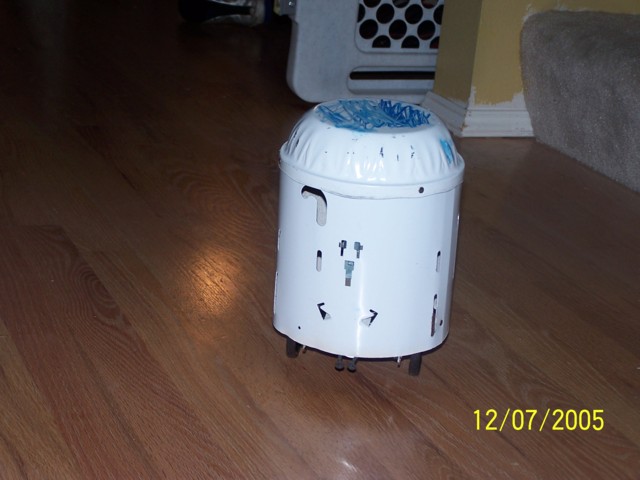Help Designing First
I bought a BOE-BOT kit and have built my first robot - R2-G2 - the "G" is for "ghetto beacuse he is externally built out of junk parts. I love it and I am hooked (picture attached). Now the question I have is - how do I proceed? What are the minimum requirements for building another bot? I am assuming that I don't need the whole kit. For instance - can I just get a carrier board and stamp and then the specific pieces I need from there? What are the benefits of the different boards available? I am a little confused. Any help is appreciated. Thanks.



Comments
I might suggest that the only thing you really need is a Stamp.· You can buy a proto circuit board at Radio Shack (or other electronics sources) and make your own.· My first robot was a Boe-bot... my second was a "self-made" Boe-bot, then I moved on from there.· Break it down into small projects.· Start with a base to mount the motors or servos on.· Then find items you can use for wheels, then mount your sensors, then build a circuit board.
Thanks.
There are many general purpose prototyping boards available.· Most of them have "standard .1" spacing.· That is , the space between each hole is .1 inches.· Boards are also available in several "patterns".· You can get them with just holes, holes with solder pads, power/ground perimiter bus with solder pads, 3 hole solder pad and bus, etc.· These all refer to the copper on the bottom of the board.
Here is just one example from Radio Shack --> http://www.radioshack.com/product.asp?catalog%5Fname=CTLG&category%5Fname=CTLG%5F011%5F002%5F002%5F000&product%5Fid=276%2D150
You then solder your components to the board.
The BS2 is acutally a bunch of small components (called "surface mount") mounted on a very small curcuit board.· This very small circuit board is the same size as some IC's (Integrated Circuit) that are designed to plug into a socket that is soldered to your board.· Here is an example socket from Jameco --> http://www.jameco.com/webapp/wcs/stores/servlet/ProductDisplay?langId=-1&storeId=10001&catalogId=10001&pa=112265CJ&productId=112265
Take note that sockets come in many widths and lenghts to accomodate a variety of IC's.
I think a good first step would be to recreate·your own·BOEBoard.· You can download the schematics from Parallax, plus you can refer to the real thing since you have one.
Let's talk voltage regulation...
It really depends on your supply voltage and how many amps you plan to draw.· The Stamp has it's own onboard voltage regulator that can accept slightly over 5 volts up to 15 volts.· This is why you can connect a 9 volt transistor battery directly to the Stamp and not damage it.· Having said that, you may consider using a voltage regulator as a "protector"·to the Stamp.· If you accidently hook up a large power supply or a huge voltage spike occurs, you can "protect" the·Stamp by ensuring that any power sent to it is regulated down to 5 volts before it ever touches it.· You can almost think of it as a fuse.
Your design may require a voltage regulator to run other components in your robot though.· For example, the Stamp can't supply enough power to run motors.· You would use a voltage regulator for these items.
Being a newbie myself, I might suggest that you go through all of the Stamps-In-Class curriculums as a way to educate yourself in basic electronics.· I also found that Scott Edwards book, "Programming and Customizing the Basic Stamp Computer", had a great intro section on electronics that required no prior knowledge.· It covers just about all of the topics we have discussed here!
·